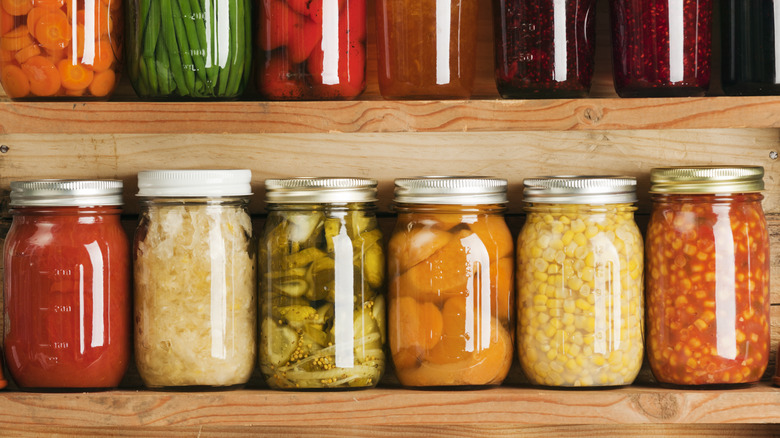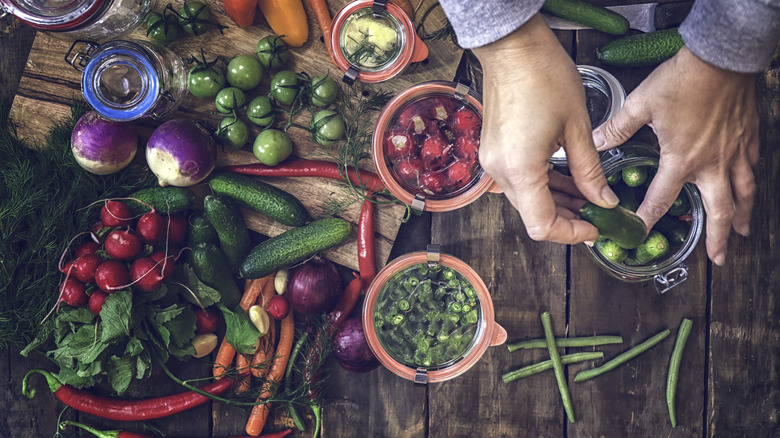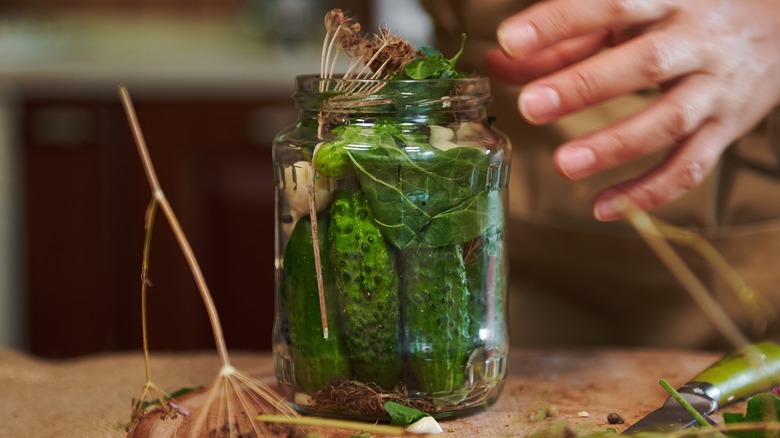Why Pickling Mixed Veggies All At Once Isn't The Best Idea
Pickling is a centuries-old preservation technique that allows fresh fruits and vegetables (as well as eggs, meat, fish, and dairy) to remain edible long after they've been plucked, picked, or harvested. For over 4,000 years, humans have relied on pickled foods during times of both abundance and scarcity. Without pickling, it may have been hard — if not impossible — for travelers to survive months-long voyages across oceans or foreign terrain.
The basics of pickling are pretty simple. You take fresh ingredients and add them to a high-acid solution for days, weeks, or months. What happens next is that the acidic liquid helps protect whatever ingredient is being pickled from spoilage. This process is easy to do at home, and you'll be able to taste (and enjoy) the results of your labor rather quickly.
That being said, there are a number of pitfalls that both amateur and advanced picklers may encounter. One of the most overlooked and common errors is pickling different types of vegetables within the same jar. Although it's natural to want to enjoy a plethora of pickled vegetables, adding them all to the same vessel won't yield the best results and may actually affect the taste, color, and texture of the finished product.
When it comes to pickling, each vegetable behaves a little differently
There are a few problems that arise from pickling a mixture of different vegetables all at once. One is that some vegetables are inherently more acidic than others, and this can affect the ratio of salt, vinegar, and water necessary to pickle them properly.
There's also the time factor. Sturdier vegetables, like thick-cut carrots or radishes, tend to require more time in the pickle jar before they become soft and tender, versus, let's say, a cucumber. Another consideration is the overall aesthetic of your pickles. When you add radishes or beets to your jar of cucumbers or turnips, the red and pink hues will soak into the brine, resulting in an undesirable color.
And finally, there's taste. A lot of pickling fun involves trying new spice blends and brines that add some funky zing to those ordinary veggies. However, some seasonings may not go with every ingredient in the jar. Carrots do well with cozy spices like clove and cinnamon, but can you really say the same for string beans and asparagus?
Other common mistakes to avoid when pickling
The pickling process is a forgiving one, but that doesn't mean it's impossible to mess up. One common mistake is adding too much sugar (or other sweetener) to your brine. Although a little sugar does make the proverbial medicine go down, you don't want to overdo it or else you run the risk of a pickling solution that's too sweet and viscous. A common ratio is 3:2:1 — 3 parts vinegar, 2 parts water, 1 part sugar.
Another important variable is choosing the right type of salt. Using ordinary table salt (iodized salt) is not recommended, because it may affect the chemical balance of your brine and cause it to become hazy or muddled. Pickling salt and kosher salt are both excellent options. And then there's your choice of vinegar. This one is actually pretty straightforward. Go for a vinegar with an acidity greater than five percent. Falling within this category are distilled white vinegar, apple cider vinegar, and even malt vinegar (although this last one has a fairly distinct taste, so use it sparingly).
At the end of the day, pickling is about trial and error. With a limitless combination of ingredients, brines, and spices, you can truly spend a lifetime making and enjoying all types of unique pickled goodies.


